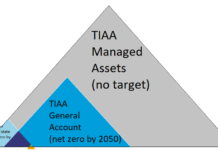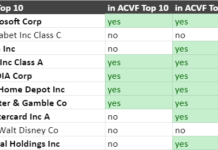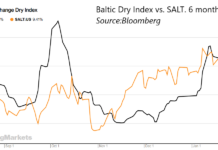| Instrument | Advantages | Disadvantages |
| Short & Ultrashort ETFs | Can use in any brokerage account | Sacrifice of upside potential, and loses money over time in volatile markets. |
| Sell Covered Calls on stocks in portfolio | Makes money in flat markets | Sacrifice of upside potential; hedge against small declines only. |
| Buy Puts on index or specific stocks | No loss of upside; protects against large losses | Works like insurance; has up-front cost. |
| Short the index | Protects against full range of index declines | Sacrifice of upside potential; must pay dividends |
| Sell naked calls on the index | Makes money in flat markets | Sacrifice of upside potential; limited downside protection. |
I list buying Short and Ultrashort ETFs first because this is the option which is most easily available to all investors. If you can buy stocks, you can buy Short or Ultrashort ETFs based on dozens of market indexes. If the underlying index rises (falls) by 2% in a day, a corresponding Short ETF will fall (rises) by approximately 2%, and an Ultrashort ETF will fall (rise) by 4%.
Unfortunately, Short and Ultrashort ETFs (along with related leveraged ETFs) have a fatal flaw which makes them unsuitable for long term use. When the underlying index is volatile, these instruments lose money over time due to the geometric nature of compounding. To give an example, SH is a short ETF designed to produce the inverse of the S&P500 daily return. The S&P500 closed on August 4 at 1005.65. On September 3, it closed at 1003.24, a decline of 0.25%. Over the same period, SH lost 0.1%, compared to the 0.25% gain you might expect. Annualized, that’s the equivalent of losing about 4.5%.
To show that this is the result of the underlying structure of SH, and not poor execution on the part of the ETF manager, we can see the same effect in a simple example. Suppose on Tuesday the S&P500 were to go from 1000 to 1100 (a 10% gain), and then fall back to 1000 on Wednesday (a 9.1% decline.) SH would fall 10% on Tuesday, and gain 9.1% on Wednesday, for a net loss of 0.90 x 1.091-1= -0.018 = -1.8%. I go into more detail in my article on Ultra ETFs from February, but the result is that these instruments are not suitable for hedging.
Selling Covered Calls on the stocks in your portfolio requires the most basic level of options permission from your broker. Given the very low risk of this options strategy, however, you do not have to have extensive knowledge or experience with options to get permission to sell (or "write") covered calls. You can follow the link for a detailed how-to; I’ll stick to the advantages and disadvantages of covered calls as a hedging strategy.
There are two main advantages. First, covered calls are tools which are reasonably a
vailable to most stock market investors with only the hour or so of work which is required to get low level options trading permission from your broker. Previous options trading experience is unlikely to be necessary, and this is a good way to get options trading experience if your broker requires it in order to start using more sophisticated options strategies.
Second, you only need the market to not go up in order to be better off by selling covered calls. Ideally, the market will be relatively stable, and you will not lose money on your stocks, but you will make gains on the calls you write.
The disadvantages of covered calls are that your downside protection is fairly limited, usually to declines of 5-10%, while you give up all the potential of upside gains in the underlying stock. This is a strategy I use with stocks that I don’t think have much potential for outsized gains. Selling covered calls is an incomplete hedging strategy offering no protection against large market declines, and so I use it only in conjunction with at least one of the other strategies listed below.
Buying Puts is very much like buying insurance on your portfolio. If you want to protect against large declines in specific stocks, you can buy puts allowing you to sell those stocks for a fixed price at a later date. If you want to protect against a large decline of an index, you can buy puts on that index (or index ETF) which will settle for cash if the index falls below the strike price, or you can buy the ETF at the future reduced price, and sell it at the strike price for a profit, offsetting losses elsewhere in your portfolio.
The main advantages of buying puts are that they offer complete protection against declines past the strike price of your choosing, and there is no loss of upside potential in your portfolio. Puts are one-sided bets. Like most one-sided bets, they come at a cost. The insurance puts offer requires paying a premium, and that premium must be renewed when they reach their expiration date.
Another advantage of buying puts is that it is only slightly harder to get options permission allowing you to buy puts than it is to get permission to sell covered calls. The strategies which follow both can entail theoretically unlimited losses, and getting permission from your broker to use them is correspondingly more difficult.
Shorting the Index (or index ETF) is the classic way to hedge. When the index goes up, you lose money on your short position, but your stock portfolio should be rising as well, insulating you from the market move. When the index declines, the gains in your short position offset the expected losses elsewhere in your portfolio.
The main advantage of shorting the index is simplicity. Unlike options strategies, you do not need to periodically renew your positions as options expire, or to adjust your exposure as the sensitivity of the options changes with market moves (more about this below). The main disadvantages are that you will need to pay any dividends declared on the security you are shorting, and you generally do not earn interest on the cash retained in your margin account to cover the short position. If the short moves against you, you may even have to come up with more cash to cover the short position, or begin paying margin interest. This is in contrast to selling/writing calls, where you are able to earn interest (or even re-invest the cash received.)
Selling (Writing) Calls on the Index (or index ETF) is a hybrid between selling covered calls and shorting the index. Unlike shorting, the balance which you need to maintain to cover the position will usually accrue interest, and you will also tend to make money on the premiums for which the calls were written if the index stays relatively flat.
This does have the disadvantage that there is little protection against declines in the index below the strike price of the call you sold. However, you can sell calls with strike prices considerably below the current level of the index (although this comes at a cost of smaller gains when the index is flat.) Another strategy is to continue selling more calls dynamically as the index declines, which works so long as the market does not decline so quickly that it is difficult to find call buyers at reasonable prices.
This has long been my primary hedging strategy, but I have recently shifted to a slightly more complex (if related) hedging strategy of selling short call spreads. I will publish a short article about this strategy later this week, when you can find it at the previous link (which will be broken until then.)
How Much to Hedge
You now should know which market factor you want to hedge against, and which hedging instruments you plan to use. It’s theoretically possible to calculate the precise number of options or shares to use in your hedge in order to achieve a particular exposure. The calculation depends on the variances and covariances of the various instruments and securities in your portfolio with the index and each other. These statistics not only require considerable market data and number crunching to calculate, but they are prone to change over time and in different market conditions, making such calculations extremely complex and even unreliable in practice.
Fortunately, there is a much simpler way to determine and refine the effectiveness of your hedge. The only data you need is daily price date for the index you have chosen to hedge against, and the daily total value of your account. The daily historical values of your account are not usually available from most brokers, so this requires logging in each evening and recording the account value. Fortunately, the method still works if you miss a day here or there.
Set up a spreadsheet with columns as follows:
| Date | Index | Acct | Index Change | Account Change | Beta |
| A1 | B1 | C1 | |||
| A2 | B2 | C2 | D2=B2/B1-1 | E2=C2/C1-1 | |
| … | … | … | … | … | |
| A3 | B20 | C20 | D20=B20/B19-1 | E20=C20/C19-1 | =CORREL(D1:D20,E1:E20)*
STDEVA(E1:E20)/ STDEVA(D1:D20) |
| A4 | B21 | C21 | D21=B21/B20-1 | E21=C21/C20-1 | =CORREL(D2:D21,E2:E21)*
STDEVA(E2:E21)/ STDEVA(D2:D21) |
Once you have the first 20 rows filled in, you can just copy the final 3 columns from a previous row in order to continue the sequence. Note that corrections will need to be made in the "Account Change" column if you take money out of or put money into your account.
The formula in the "Beta" column uses Microsoft Excel functions to calculate the Beta for your account relative to the index over the last 20 trading days (approximately 1 month). In other words, for every 1% change in the index over the last 20 trading days, your account changed Beta percent. A perfectly hedged account will have a Beta of 0.
Below is a graph of Beta for my largest account
for this year against three indexes: The S&P500, the Nasdaq, and the Dow Jones Total Stock Market index. The magenta line shows the trend for the account itself, while the red line is a composite of those three indexes (click on the chart for a higher resolution view.)
As you can see, I started the year with a Beta of around 0.6. At that time, I was participating in 60% of the gains and losses from general market trends. I maintained a moderately positive Beta at the start of the year because I was cautiously bullish on the market as a whole. In April, I began to feel that the market was advancing too far, too fast and I began to increase my hedge by selling calls on market index ETFs. By early June, I had become increasingly bearish, and published my market call saying "we’re near the peak." Since then, I have continued to hedge, and now the account has a Beta near zero, meaning that changes in the account value will have more to do with my particular stock picks than with general market moves.
By monitoring your own spreadsheet, you can have a good idea how effective your hedge is operating. If you expect the market to decline, you should keep your own account’s Beta at zero, or even negative. If you’re aggressively bullish, you’ll want a Beta near 1 or higher. You can raise your account’s Beta by decreasing the size of your hedge or adding to your stock portfolio, and you can decrease your account’s hedge by selling stocks or adding to your hedge. This is what I meant earlier when I referred to "selling more calls dynamically."
A Watchful Eye
The key to hedging is regular monitoring, preferably daily. The increase in my account’s Beta in June was not due to me decreasing my hedge, but to changes in the internal correlations of the market. You account’s Beta will tend to drift over time due to such changes, and effective hedging requires that you make occasional trades to keep it near the desired level.
For most investors, the daily monitoring required to keep a portfolio properly hedged is probably too much work. If that is the case for you, and you also feel that the market is likely to decline, the best strategy is probably to sell most of your stock portfolio and wait on the sidelines until the market declines to better valuations. The use of simple hedging strategies such as shorting the index may compensate somewhat for less frequent monitoring, but changing market conditions mean that even this strategy is probably only appropriate for relatively active investors.
DISCLOSURE: None.
DISCLAIMER: The information and trades provided here and in the comments are for informational purposes only and are not a solicitation to buy or sell any of these securities. Investing involves substantial risk and you should evaluate your own risk levels before you make any investment. Past results are not an indication of future performance. Please take the time to read the full disclaimer here.










“Staying out of the market makes financial sense for the index investor, who knows that he or she does not have the skills, time, or knowledge to beat the market.”
Is this what you meant to say? It seems out of place with the rest of the paragraph (and even with the second half of itself, which says index investors haven’t the skills to time the market).
Ted,
Thanks for pointing that out. It should be clearer now.